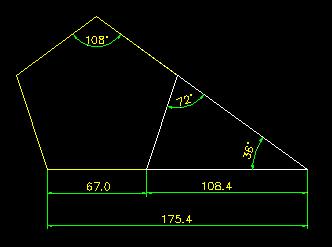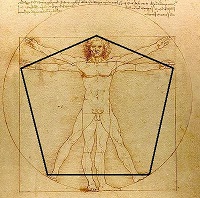Height of a Man
Ihmisen pituus
It has been estimated from the various figures and numbers that no reality can be found in them. The same is mentioned in number five in connection with the pentagon, which Pythagoras considered a sacred number and pattern.
The idea of EP-calculation is that it is not necessary to see what is being calculated. For example, the length of the skeleton is 175.4 cm, in which case you want to know what height the navel has been during a person's life. The measurement is obtained by scaling the pattern with a drawing program or by calculating it according to the upper example.

The skeletal length of 175.4 cm is a known data from which the unknown location of the navel as measured from the stem is;
175.4 cm / 1.618 cm = 108 cm
By knowing the navel location, the height of a man is;
108 cm x 1.618 cm = 175.4 cm
We are carrier for the Golden Ratio 1.618

By scaling the pattern, you can find out the desired dimension.
The calculation on this page is about EP-physiology, but also visual geometry. All animals have similar proportions, as do humans. Not only in the living bodies, for the machine parts also contain the same proportions.
Navel Location
When measuring the location of the navel, it is good to think about where the navel is located at normal weight if it is not hanging over the abdomen. Normal weights also have abnormalities in body structure, so no completely exact location can be assigned to the navel according to the previous examples. Nature by the way, is full of anomalies anyway, but on a large scale the handbook of nature is followed and is calculated by EP-calculation.
We calculate proportionality with less than 5% accuracy. For example, the position of the navel of a 180 cm tall person may differ by a few centimeters. There are individuals with disproportionately long legs and short ones. Both deviating dimensions are not optimal and in some cases can be inferred from walking.
Leonardo da Vinci

Leonardo da Vinci investigated the human dimensions.
Painting:
Leonardo da Vinci - Marcus Vitruvius Pollio
Marcus Vitruvius Pollio (born c. 80–70 BC, died after c. 15 BC) was a Roman writer, architect and engineer

2.5.2015*11:00 (1083 - 1084)
www.karikolehmainen.com
epcalculation@gmail.com |